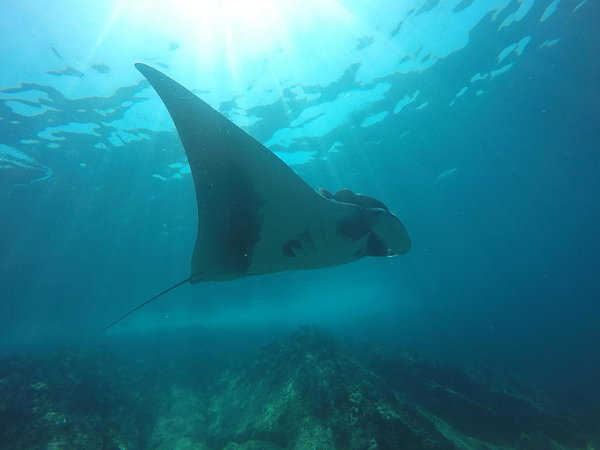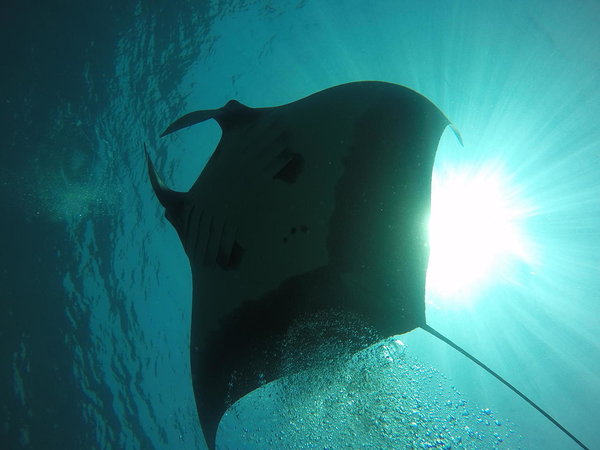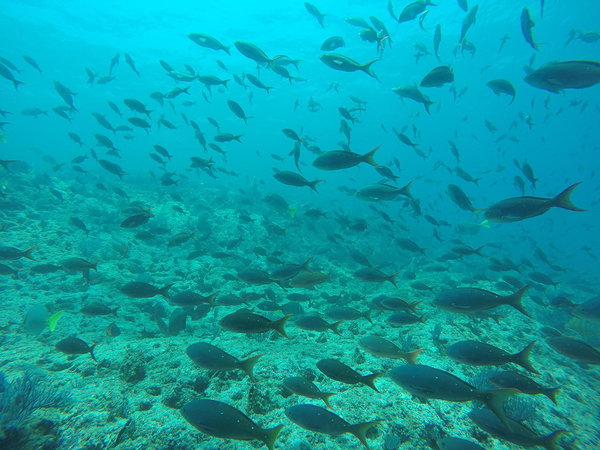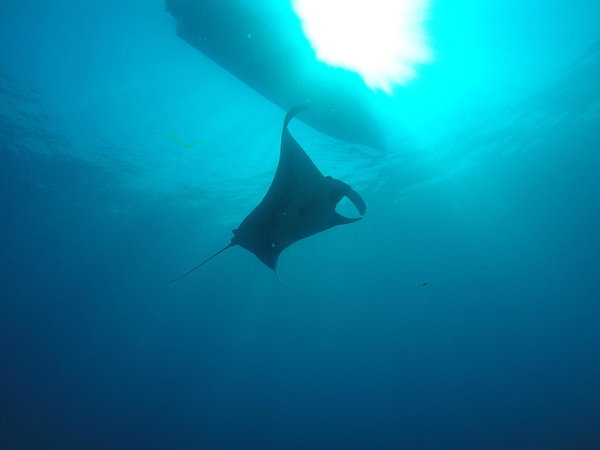Giant Manta Rays
In 2002, Giant manta Rays (Mobula birostris) were a common sight at one of the islands near La Paz. North of Cerralvo Island is a small rock outcrop called La Reina, being that it is in the middle of open water this rock outcrop attracted huge numbers of schooling fish and giant mantas too. This month, we are celebrating the return of the mantas! A few weeks ago a juvenile chevron giant manta at La Reina was tagged with a satellite transmitter. This work is being carried about by a collaboration of different organisations (Pelagious Kakunja, Whale Shark Mexico, Pelagic Life) and to try to better understand their movements and lifestyle.
It is unknown why the mantas disappeared, it is thought to be due to overfishing; not just with mantas being caught as by catch but also as a product themselves to be sold at the market or eaten by local fishing communities. Mantas have been spotted a couple of times over the last few years but sightings were more sporadic and they didn't stay for very long. The last couple of weeks there have been a number of documented sightings of different individuals. There are also a few organisations who are combining resources to get some satellite tags on them so that more can be learnt about these beautiful rays.
The Giant Manta or Mobula birostris is the largest in the ray family (hence the name!) and they are truly an amazing sight to behold. They can have a wingspan upto 7m but to see this size is unusual, more common is 4-5m (12-15ft). Like our other large fishy visitor the whale shark, manta rays feed on plankton. At the front of their body they have cephalic fins which can be unrolled and extended to help channel food into their mouth. When swimming and travelling these fins get rolled up to make them more hydrodynamic. The appearance of these fins look like horns and for many years mantas were called devil fish and feared due to their size; only in recent years have people come to revere rather than fear these magnificent creatures.
As recently as 2009 it was thought that manta rays were all one species but there are 2 different members - reef and oceanic - differentiated by their size and also colouration. Other members of the mobula family are much smaller but are commonly seen here in Baja jumping out of the water - usually mobula munkiana. Many times you can be out on a trip and the captain or guide will say 'Manta!' but they are usually mobula rays - they look very similar but are much smaller and often found in large congregations. I'll talk more about them another time.
We can't guarantee that they will be seen if we visit La Reina but they are a nice surprise! Best seen during the summer months when the water is a little warmer. La Reina is a site that is exposed and can only be visited when the weather is good - this can be harder in winter as it is exposed to the prevailing north wind - it is also subject to strong currents so be prepared when diving here. There is lots of other life to be seen - sealions, eels, nudibranchs, schools of barracuda and jacks. Some friends of ours even saw a juvenile whaleshark the other day too!
The Giant Manta or Mobula birostris is the largest in the ray family (hence the name!) and they are truly an amazing sight to behold. They can have a wingspan upto 7m but to see this size is unusual, more common is 4-5m (12-15ft). Like our other large fishy visitor the whale shark, manta rays feed on plankton. At the front of their body they have cephalic fins which can be unrolled and extended to help channel food into their mouth. When swimming and travelling these fins get rolled up to make them more hydrodynamic. The appearance of these fins look like horns and for many years mantas were called devil fish and feared due to their size; only in recent years have people come to revere rather than fear these magnificent creatures.
As recently as 2009 it was thought that manta rays were all one species but there are 2 different members - reef and oceanic - differentiated by their size and also colouration. Other members of the mobula family are much smaller but are commonly seen here in Baja jumping out of the water - usually mobula munkiana. Many times you can be out on a trip and the captain or guide will say 'Manta!' but they are usually mobula rays - they look very similar but are much smaller and often found in large congregations. I'll talk more about them another time.
We can't guarantee that they will be seen if we visit La Reina but they are a nice surprise! Best seen during the summer months when the water is a little warmer. La Reina is a site that is exposed and can only be visited when the weather is good - this can be harder in winter as it is exposed to the prevailing north wind - it is also subject to strong currents so be prepared when diving here. There is lots of other life to be seen - sealions, eels, nudibranchs, schools of barracuda and jacks. Some friends of ours even saw a juvenile whaleshark the other day too!




